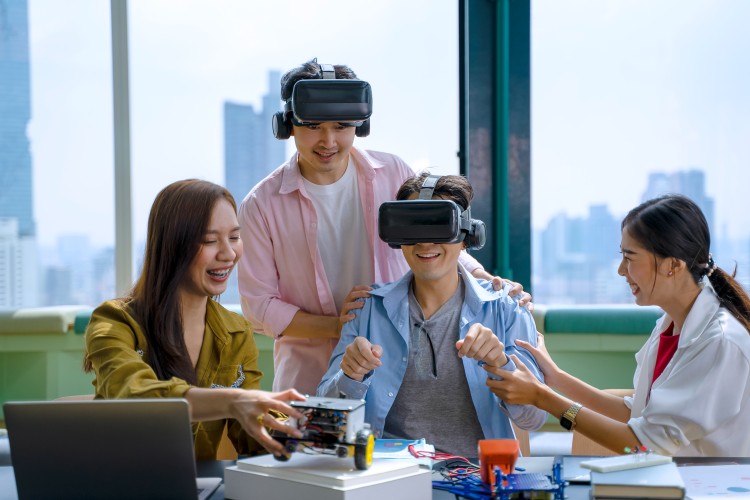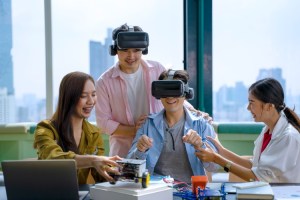Evolution of Education: The Metaverse’s Influence on Online Education

The metaverse involves the convergence of many different technologies — such as virtual reality (VR), augmented reality (AR), artificial intelligence (AI), wearable haptic technologies, electromyography (EMG) technology, and neural interfaces — with the collective potential to produce immersive online worlds filled with new ways to connect and learn.

With over $120 billion having flowed into the creation of metaverse assets in 2022 alone, according to McKinsey & Company, how is the metaverse shaping online learning environments? Students and teachers with interest in student-centered learning will be excited to discover how the metaverse is already influencing the evolution of education.
Who Makes the Metaverse?
The future of education is in the hands of those who design it. While still under construction, the metaverse offers opportunities to create more equitable, accessible, and engaging online learning environments.
Early leaders in the field are operating in tandem to build immersive 3D environments set to revolutionize how people connect in virtual and mixed-reality worlds. From Google to Meta, Microsoft to Apple, Qualcomm to NVIDIA — not to mention gaming companies such as Roblox, Epic, and Unity — top tech companies and stakeholders are driving the development of the metaverse.
Large companies aren’t alone in pouring resources into creating the metaverse. Teachers, digital designers, policymakers, and researchers can all lend their skills to add to the tapestry of new technologies poised to radically shift the online education experience.
Wearable Technology
One of the many exciting features of the metaverse is the promise of connecting physical and digital spaces. New wearable technologies, such as AR technology and haptic technology, exist on the cutting edge of education innovation.
AR Technology
What’s the next phase in the evolution of education? Augmented reality technology that combines digital information with the physical world in real time.
AR glasses are an example. People have used eyeglasses for hundreds of years to improve their vision. AR glasses are wearable glasses that not only correct vision but add information — such as 3D images, animations, and text — to the user’s line of sight. A student learning about plants in springtime while wearing AR glasses may be able to quickly scan and identify the name and species of a specific tree, for example, and the AR glasses could also produce a visual display of what its fruit will look like when it is in season.
AR glasses have the capability to retrieve information from a number of sources, including smartphones and devices that support Wi-Fi, Bluetooth, and GPS — making AR glasses a powerful teaching tool for young and older learners alike.
Haptic Technology
Students don’t just learn from the senses of sight and hearing. Technologies with haptic feedback, which simulates the sensations of touch, can also help students who learn in more tactile ways.
Devices such as haptic gloves can provide physical feedback to learners through vibrations. As a result, a person wearing a VR headset and “holding” a virtual object can have a greater sense of immersion. These technologies hold great promise for providing students with interactive learning experiences.
Accessible Design
Designers can create wearable technologies that expand access for people with disabilities. The impact of online education designed with accessibility in mind will be greater student engagement and improved communication.
Google is currently working on AR glasses with live audio-to-text translation, which would allow the wearer to see the words that a person in front of them is speaking. The goal is to provide an experience “almost like closed captioning for real life,” a Google spokesperson explains. Such technologies are just one example of a design that could help break down barriers and support people who are deaf or hard of hearing.
AI Technology
Artificial intelligence (AI) is already revolutionizing education, healthcare, and business through its ability to parse massive amounts of data, making information and insights available on a scale never seen before.
In the metaverse, AI is likely to play many important roles. For example, it may enable the scalability and automation of the metaverse “more than any other technology” we have today, as Carlos Meléndez of the Forbes Technology Council predicts. AI has the power to drive deep learning — a type of machine learning that allows neural networks to simulate the behavior of a human brain and “learn” from massive datasets (billions of individual inputs that would take years for a person to process on their own).
With their ability to process information and look for patterns, AI tools can empower learning plans and activities in the metaverse that are customized to the specific needs of each learner in a classroom. For example, a student is trying to pass calculus who learns differently from their peers. In the metaverse, an AI tool could draw from an international repository of calculus teaching tools to find exercises and supplemental instruction tailored to their unique learning style.
Gamification
The process of gamification is applying design elements from game design to new settings. People design games to stimulate, motivate, challenge, reward, and entertain — all of which make games fun and highly engaging.
In many ways, the gaming community is already actively shaping metaverse development — from game streaming platforms like Twitch that connect millions of gamers a day from around the globe to watch and chat about live gameplay to the 3D avatars that populate early prototypes of metaverse virtual meeting rooms and classrooms. Insights from online gaming can help educators and designers make the next step in the evolution of education more interactive.
Some examples of the ways that the metaverse can enable teachers to gamify their classrooms include:
- Creating objectives or “quests” for students to learn from (which can include either individual or collaborative learning objectives)
- Teaching abstract concepts and narratives through online games
- Encouraging the development of creativity and self-expression through the customization of online classroom avatars, interactive 3D displays, and presentations for virtual and augmented reality learning environments
- Making opportunities for developing mastery in a specific subject area through online drills, exercises, and performances
Immersive Learning
A word almost always associated with the metaverse is immersion. How can the metaverse improve learning outcomes through deep immersion?
Students and teachers alike may be interested in exploring the ways that interfacing with the metaverse can foster the six C’s of learning established by Brian S. Miller:
- Collaboration
- Communication
- Critical thinking
- Creative innovation
- Content
- Confidence
Collaboration
Students can develop the skills of collaboration — trust, flexibility, open-mindedness, and the ability to navigate interpersonal conflict respectfully, to name a few — in open-ended learning environments within the metaverse.
Students already use online tools to work together to solve problems, make progress on homework assignments, and complete group projects. The metaverse, with its integration of AR, VR, wearable technologies, and AI machine learning, offers nearly limitless possibilities for students to collaborate, try out, and share their best ideas.
Communication
The internet already allows people from all over the world to communicate in real time, but the metaverse promises to empower an even more immersive, embodied communication experience.
Researchers at the Virtual Human Interaction Lab at Stanford and elsewhere who study the physical and psychological effects of prolonged videoconferencing (through platforms such as Zoom) over the duration of the pandemic found that many current aspects of the experience can be exhausting. Exposure to “excessive close-up eye contact,” seeing oneself during video chats, and sitting in the same place to video chat all contribute to a phenomenon known as “Zoom fatigue” — feeling more physically and emotionally drained after virtual meetings, compared with in-person meetings.
The metaverse, with its emphasis on integrating the best of digital resources as well as haptic technology, AR, and VR, may be poised to learn from this era of videoconferencing — implementing interface changes that minimize fatigue when interacting with others.
Critical Thinking
Educators including teachers and librarians know that knowledge centers have changed. Information intake via smartphones, tablets, and personal computers may be at an all-time high, but information literacy (the ability to do research and to distinguish evidence-based information from misinformation) continues to lag.
These professionals also understand that critical thinking is a communal activity as much as it is individual. We learn from the people around us, and those we spend time with most often (whether in person or in digital spaces such as social media platforms and gaming communities) often reinforce rather than challenge our existing ideas and worldviews.
As a communal space for creating and sharing information, the metaverse will not be automatically immune from misinformation and disinformation. So, students should learn early and often how to think for themselves, how to ask questions, how to spot logical fallacies, and how to conduct evidence-based research.
Creative Innovation
Emerging trends in 3D modeling software and wearable technologies offer exciting opportunities for “hands-on” learning, as well as enabling students to create their own content to share with the world. Students wearing VR headsets can virtually tour historical sites, such as museums and monuments, without schools footing the bill for international travel. Also, students with haptic gloves can build, sculpt, and rotate unique 3D objects — technologies that are already revolutionizing engineering and design content.
Content
Gone will be the days of rote memorization based on listening to a single course lecturer.
Content in the metaverse will come from an array of sources — independent creators, content experts including professors and business leaders, and teams of forward-thinking designers and engineers all working together to create immersive, interactive content experiences.
For example, medical students will be able to view, rotate, and zoom in on high-definition 3D models of molecular bodily processes to better learn notoriously challenging topics such as biochemistry, pathology, and neuroanatomy.
Confidence
Metaverse learning environments can encourage active, engaging, joyful, and meaningful interactions that inspire student confidence. Lesson plans should cover many of the technologies that will be used in rapidly developing fields such as healthcare, tech, and business, so students will have the technological literacy and proficiency to contribute fully and fearlessly.
Shape Your Future in a Changing World
With the potential to blend physical and virtual learning spaces and create entirely new environments for immersive educational experiences, the metaverse is likely to advance the evolution of education. Colleges and universities have a responsibility not just to keep up with technology trends that affect higher education but to take an active part in shaping a more inclusive, interactive, and immersive educational system for everyone.
Students who want to take the next step in their education should consider enrolling in a school that understands the value of innovative technologies. In Maryville University’s online degree programs, students can learn from experts who are excited to teach the next generation of leaders in healthcare, technology, business, and other fields soon to be revolutionized through the metaverse. Discover your educational path at Maryville University.
Recommended Reading
Maryville University & Monster Worldwide’s Data on Upskilling & Reskilling Needs in the Workforce
A Conversation with an Enrollment Advisor on Nursing Programs
Sources
Brookings Institute, “A Whole New World: Education Meets the Metaverse”
Cambridge University Press, “‘Metaverse’ and the Educational Potential”
EdSurge News, “Can the Metaverse Improve Learning? New Research Finds Some Promise”
EdTech Magazine, “The Metaverse Is Already Here, and K–12 Schools Are Using It for Education”
Fast Company, “The Metaverse Can Provide a Whole New Opportunity for Education”
Forbes, “The Metaverse: Driven by AI, Along with the Old Fashioned Kind of Intelligence”
McKinsey, “Value Creation in the Metaverse”
Miro, “The 6 C’s of Education”
Stanford News, “Stanford Researchers Identify Four Causes for ‘Zoom Fatigue’ and Their Simple Fixes”
VentureBeat, “The Metaverse: Where We Are and Where We’re Headed”

